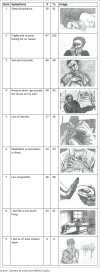The development of the visual screening tool for anxiety disorders and depression: Addressing barriers to screening for depression and anxiety disorders in hypertension and/or diabetes
- PMID: 29943612
- PMCID: PMC6018456
- DOI: 10.4102/phcfm.v10i1.1721
The development of the visual screening tool for anxiety disorders and depression: Addressing barriers to screening for depression and anxiety disorders in hypertension and/or diabetes
Abstract
There is a lack of screening tools for common mental disorders that can be applied across cultures, languages and levels of education in people with diabetes and hypertension. Aim: To develop a visual screening tool for depression and anxiety disorders that is applicable across cultures and levels of education. Setting: Participants were purposively recruited from two not-for-profit organisations and two public health facilities - a maternal mental health unit and a primary health care centre. Method: This was a qualitative cross-sectional study. Thirteen drawings based on the Hospital Anxiety and Depression Scale depicting symptoms of anxiety disorders and depression were drawn. Participants described emotions and thoughts depicted in the drawings. Data were analysed through content analysis. Results: Thirty-one women (66%) and 16 men (34%) participated in the development of the visual screening tool. The mean age was 34 (standard deviation [SD] 12.46). There were 32 (68%) black participants, 11 (23%) mixed race participants and 4 (9%) white participants. Two participants (4%) had no schooling, 14 (31%) primary schooling, 8 (18%) senior schooling, 13 (29%) matric qualification and 8 (18%) had post-matric qualification. Participants correctly described 10 out of the 13 visual depiction of symptoms as associated with depression and anxiety disorders, with no differences between levels of education and cultural groups. Conclusion: Ten drawings were appropriate for inclusion in the visual screening tool for anxiety disorders and depression (VISTAD). The VISTAD will be validated against the mini international neuropsychiatric interview (MINI) in a primary care population with hypertension and/or diabetes.
Keywords: anxiety; depression; diabetes; hypertension; screening; visual screening tool.
Conflict of interest statement
The authors declare that they have no conflicts of interest to disclose. Neither personal nor financial relationship may have inappropriately influenced them in writing this article.
Figures
Similar articles
-
Diagnostic indicators of anxiety and depression in older dizzy patients in primary care.J Geriatr Psychiatry Neurol. 2011 Jun;24(2):98-107. doi: 10.1177/0891988711405332. J Geriatr Psychiatry Neurol. 2011. PMID: 21546650
-
Reliability and validity of a Chinese version of the HADS for screening depression and anxiety in psycho-cardiological outpatients.Compr Psychiatry. 2014 Jan;55(1):215-20. doi: 10.1016/j.comppsych.2013.08.012. Epub 2013 Oct 7. Compr Psychiatry. 2014. PMID: 24199886
-
A Web-based screening instrument for depression and anxiety disorders in primary care.J Med Internet Res. 2003 Jul-Sep;5(3):e23. doi: 10.2196/jmir.5.3.e23. Epub 2003 Sep 29. J Med Internet Res. 2003. PMID: 14517114 Free PMC article.
-
Screening for depression and anxiety among older Chinese immigrants living in Western countries: The use of the Geriatric Depression Scale (GDS) and the Geriatric Anxiety Inventory (GAI).Asia Pac Psychiatry. 2016 Mar;8(1):32-43. doi: 10.1111/appy.12191. Epub 2015 May 22. Asia Pac Psychiatry. 2016. PMID: 26010903 Review.
-
Depression in diabetes patients. An overview of screening tools for use in primary care settings.Adv NPs PAs. 2013 Jul;4(7):26-9; quiz 30. Adv NPs PAs. 2013. PMID: 23923222 Review. No abstract available.
References
-
- Berge LI, Riise T, Tell GS, et al. . Depression in persons with diabetes by age and antidiabetic treatment: A cross-sectional analysis with data from the Hordaland Health Study. PLoS One. 2015;10(5):e0127161 https://doi.org/10.1371/journal.pone.0127161 - DOI - PMC - PubMed
-
- Hasan SS, Clavarino AM, Dingle K, Mamun AA, Kairuz T. Diabetes mellitus and the risk of depressive and anxiety disorders in Australian women: A longitudinal study. J Womens Health. 2015;24(11):889–898. https://doi.org/10.1089/jwh.2015.5210 - DOI - PubMed
-
- Roy T, Llyod CE. Epidemiology of depression and diabetes: A systematic review. J Affect Disord. 2012;142(Suppl 1):S8–S21. https://doi.org/10.1016/S0165-0327(12)70004-6 - DOI - PubMed
-
- Semenkovich K, Brown ME, Svrakic DM, Lustman PJ. Depression in type 2 diabetes mellitus: Prevalence, impact, and treatment. Drugs. 2015;75:577–587. https://doi.org/10.1007/s40265-015-0347-4 - DOI - PubMed
-
- Stein DJ, Aguilar-Gaxiola S, Alonso J, et al. . Associations between mental disorders and subsequent onset of hypertension. Gen Hosp Psychiatry. 2014;36(2):142–149. https://doi.org/10.1016/j.genhosppsych.2013.11.002 - DOI - PMC - PubMed
MeSH terms
LinkOut - more resources
Full Text Sources
Other Literature Sources
Medical

